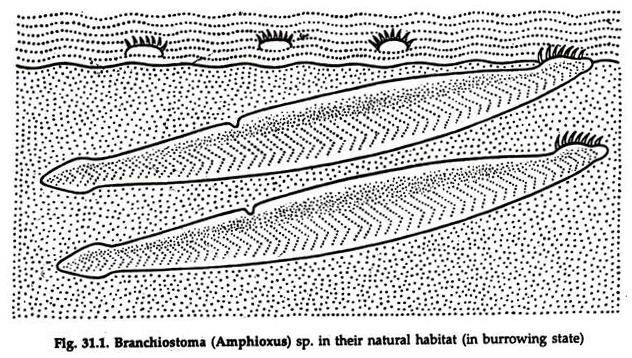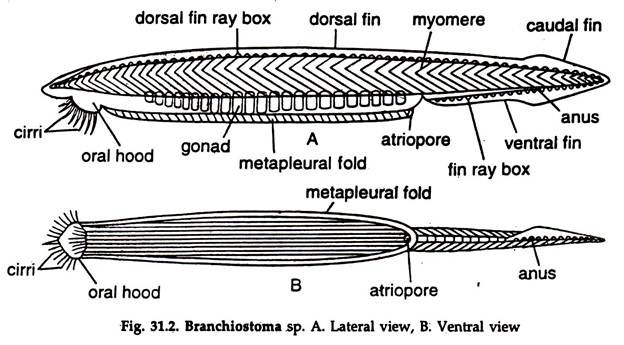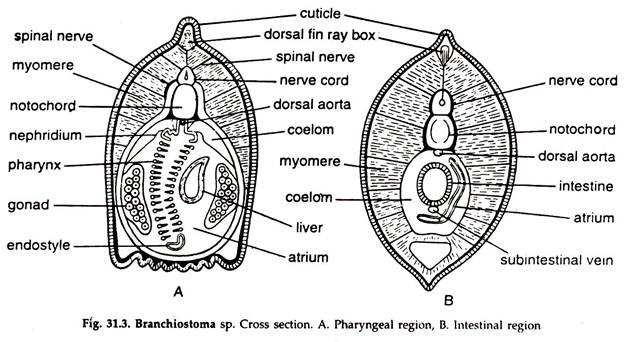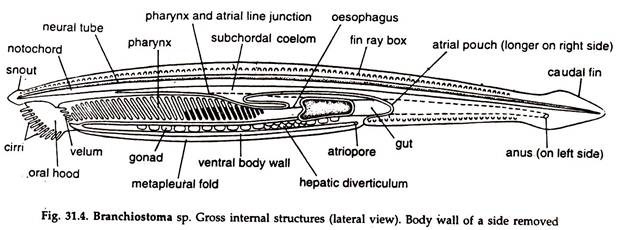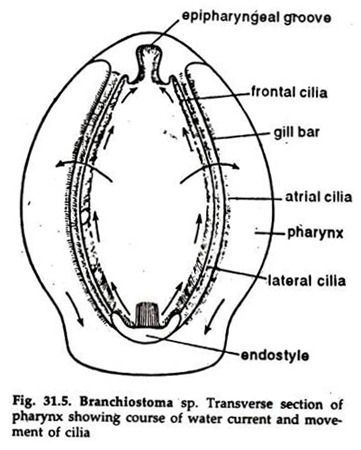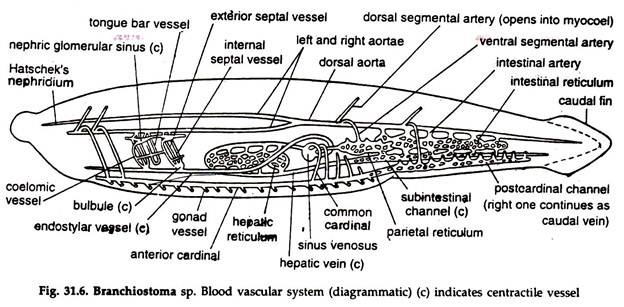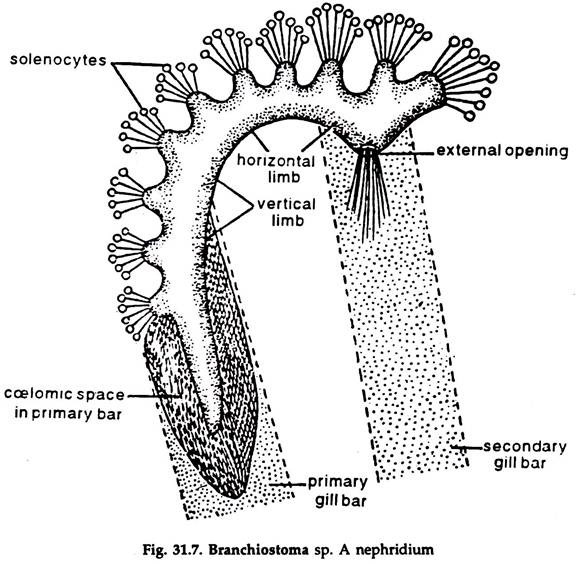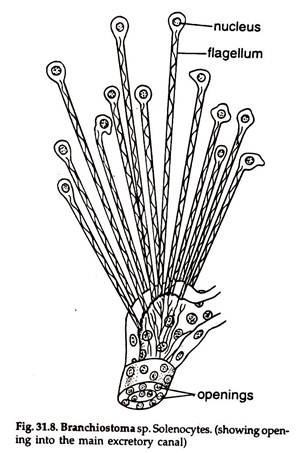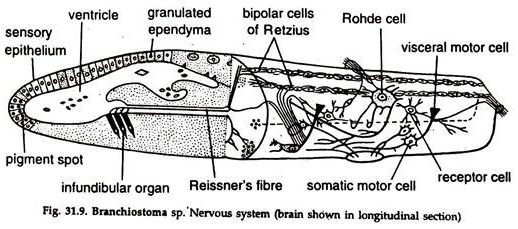In this article we will discuss about:- 1. Description of Branchiostoma 2. External Features of Branchiostoma 3. Body Wall 4. Skeletal System 5. Locomotion 6. Digestive System 7. Respiratory and Feeding Mechanism 8. Blood Vascular System 9. Excretory System 10. Nervous System 11. Reproductive System.
Contents:
- Description of Branchiostoma
- External Features of Branchiostoma
- Body Wall of Branchiostoma
- Skeletal System of Branchiostoma
- Locomotion in Branchiostoma
- Digestive System of Branchiostoma
- Respiratory and Feeding Mechanism in Branchiostoma
- Blood Vascular System of Branchiostoma
- Excretory System of Branchiostoma
- Nervous System of Branchiostoma
- Reproductive System of Branchiostoma
1. Description of Branchiostoma:
Branchiostoma belongs to class Cephalochordata, subphylum Acrania, phylum Chordata. Branchiostoma dwells in the shallow waters of tropical and semitropical seas and has apparently retained a great many relatively simple features, despite the fact that it has probably evolved a long way from the actual ancestors of chordates.
ADVERTISEMENTS:
This small animal shows the chordate plan reduced to almost its lowest terms and its development and structure point the way to the rise of complicated conditions found in higher vertebrates.
It is a sand-burrowing animal, the greater part of the body remains (Fig. 31.1) in sand, only with the anterior end protruding. It burrows rapidly in sand with head or tail foremost. It is capable of swimming but erratically.
Branchiostoma are distributed from Mediterranean to North Sea. The Indian species are Branchiostoma caribbaeum, B. indicum and B. pelagicum.
ADVERTISEMENTS:
ADVERTISEMENTS:
2. External Features of Branchiostoma:
1. Branchiosloma is a transparent, fishlike animal occurring near the shore, burrowing in sand.
2. The body is narrow, 2.5-5.8 cm long, laterally compressed and pointed at both the ends. The anterior two-thirds of the body is triangular in cross-section.
3. Along the mid-dorsal line a dorsal fin extends the whole body length. It is joined posteriorly to a somewhat broader caudal fin around the tail (Fig. 31.2).
4. A ventral fin is situated mid-ventrally running from the caudal fin to a median opening, the atriopore.
5. The muscles are arranged in sixty-two V-shaped segments or myotomes.
6. Three unpaired apertures are present:
a. The mouth overarched by the median, ventral oral hood, and fringed with tentacle-like cirri.
b. The atriopore in myotome thirty-six is to expel water from the pharynx which enters through the mouth.
c. The anus is ventral and slightly to the left behind the atriopore, at some distance from the posterior end of the body.
7. The notochord is flexible, un-segmented rod, pointed at both the ends and runs from one to the other end of the body.
8. The pharynx is supported by gill rods, which border the numerous gill slits.
9. The intestine is straight and without any loop.
ADVERTISEMENTS:
10. The hepatic diverticulum is simple.
11. The circulatory system is ill-developed. A definite heart is absent but the ventral or the branchial artery is rhythmically contractile.
12. The blood is colourless. A few amoeboid cells are present in it.
13. About ninety pairs of segmentally arranged nephridia are present on the dorsolateral walls of the pharynx.
14. The dorsal nerve cord is shorter than the notochord, above which it lies.
15. A definite brain is absent although anteriorly the central canal of the nerve cord widens to form the so-called cerebral vesicle, also called brain.
16. Two sets of nerve roots are present. The two sets of roots do not unite as in
vertebrates. Spinal and sympathetic ganglia absent.
17. The sexes are separate but similar. The gonads are segmental and without duct.
3. Body Wall of Branchiostoma:
1. The body is covered with a cuticle bearing numerous pores.
2. An epidermis of a single layer of columnar cells underlines the cuticle. Some of the epidermal cells form unicellular glands and some are epidermal nerve cells.
3. The dermis beneath the epidermis is formed chiefly of connective tissue.
4. The muscular layer is metamerically segmented and consists of about sixty muscle-segments or myomeres (myotomes) (Fig. 31.2) separated from one another by myocommas or partitions of dense connective tissue.
5. In surface view, the myotomes appear as a series of open V’s with forwardly directed apices.
6. Flat, striated muscle-plates are arranged longitudinally in each myotome, enabling its attachment to the successive myocommas.
7. The myotomes of the right and left sides are arranged not in opposite but alternately.
8. In the floor of the atrial cavity a set of transverse muscles extends across the ventral surface of the anterior two-thirds of the body.
9. The dorsal portion of the muscular layer of the body wall (Fig. 31.3) is greatly thickened.
4. Skeletal System of Branchiostoma:
Notochord, oral ring, gill rods and fin rays constitute skeletal system:
Notochord:
Notochord, the main supporting structure is a cylindrical rod tapering at both ends and extends the whole length of the body (Fig. 31.4) along mid-dorsal line, above alimentary canal. Notochordal tissue formed of large vacuolated cells constitutes the notochord.
It is enclosed in a sheath—the notochordal sheath. A structure-less layer secreted by the cells of notochord occupies the space between the two. The principal function of the notochord is to prevent shortening of the body during contraction of longitudinal muscles.
Oral ring:
A ring made of cartilage-like matter; the oral ring, supports the oral hood. The ring consists of separate rod-like pieces arranged end to end corresponding with the number of cirri. From each piece an offshoot runs into the cirrus and supports it.
Gill rods:
The pharynx is supported by branchial rods made of elastic fibres .
Fin rays:
Short rods of connective tissue, the fin rays support the fin. The fin rays are in a single series in the dorsal fin but of double series in the ventral fin.
5. Locomotion in Branchiostoma:
Branchiostoma is. a sluggish animal but it can swim freely. Swimming is effected by contraction of longitudinal muscles of the body. Transverse motion of the body at different angles due to contraction of the myotomes helps the animal to move forward.
The myotomes contract anteroposteriorly to produce waves of contraction from the anterior to the posterior. Myocommas are attached to the notochordal sheath and the notochord helps in efficient contraction of myotomes.
Atrium:
The atrium is a wide space between the body wall and pharynx. In cross section it is crescentic (Fig. 31.3A), surrounding the ventral and lateral regions of the pharynx. The atrium is closed in front, opens outward by an atriopore behind the level of the pharynx, and extends backward as a blind pouch. The cavity is lined with atrial epithelium of ectodermal origin.
Coelom:
The coelom (Fig. 31.3) is divided into a number of compartments. The alimentary canal is surrounded by the coelom. In the pharyngeal region, the coelom is restricted in paired cavities, one on either side of the dorsal region of the pharynx, above the atrium. The cavities extend as narrow canals in the primary branchial lamellae and continuous with a median elongated space beneath the endostyle.
The coelom surrounding the intestine is much reduced on the right side. The hepatic diverticulum is lodged in a forward extension of the coelom on the left side. In the metaplaures the coelom exists as separate cavities. The spaces in the gonadal pouches are coelomic in origin.
6. Digestive System of Branchiostoma:
Mouth, foregut, midgut, hindgut, anus and hepatic diverticulum constitute digestive system (Fig. 31.4):
The pharynx and oesophagus comprise the foregut, the portion between oesophagus and ileocolon ring is midgut and the rest or the intestine is hindgut.
Mouth:
The mouth is situated at the base of a vestibule overarched by a median ventral oral hood containing tentacle-like structures, called buccal cirri. The oral hood contains a complex set of ciliated tract, the wheel organ. The mouth is surrounded by a membrane, the velum, and is fringed by twelve velar tentacles and leads posteriorly into the pharynx.
Pharynx:
The pharynx is a high, compressed chamber and occupies anterior half of the body (Fig. 31.4).
1. The walls of the pharynx are perforated by nearly 200 oblique vertical slits, the gill slits or branchial apertures.
2. The portions of the pharyngeal wall separating the clefts are known as branchial lamellae.
3. Each lamella is supported towards its outer edge by a rod made of elastic fibres, the branchial rod.
4. The rods are united with one another dorsally by loops but free ventrally.
5. The rods at their free ends are alternately forked and simple and known as primary and secondary branchial rods, respectively.
6. The branchial lamellae bearing the primary rods are primary lamellae and those lodging the secondary rods are secondary lamellae.
7. Transverse branchial lamellae supported by branchial rods connect the primary lamellae at regular intervals.
8. The inner and lateral faces of each lamella are provided with long cilia.
9. On the ventral wall of the pharynx is a longitudinal groove, the endostyle. The groove is composed of four tracts of mucous glands, each separated from the other by tracts of ciliated cells.
10. A longitudinal groove, the epipharyngeal or hyper-pharyngeal groove, lined with cilia is present on the dorsal surface of the pharynx.
11. A pair of lateral grooves, the peripharyngeal bands encircle the mouth at the anterior end of the endostyle. They meet dorsally and join with the epipharyngeal groove.
12. The pharynx opens into the oesophagus.
Oesophagus:
1. The oesophagus joins the midgut posteriorly. At the junction of the two a large pouch, the hepatic diverticulum or liver or midgut diverticulum is present.
a. The diverticulum runs forward for some distance along the pharynx on its right side.
b. Large cilia are present on the inner surface of the dorsal and ventral walls.
c. Zymogen cells in the diverticulum secrete hydrolyzing (digestive) enzymes.
2. The densely ciliated posterior end of the midgut is called ileocolon ring.
Hindgut:
The narrow hindgut (intestine) rims straight backward from the ileocolon ring and opens in the ventral anus, slightly to the left.
7. Respiratory and Feeding Mechanism in Branchiostoma:
Cilia of the wheel organ and pharyngeal wall maintain a continuous flow of water, which enters the pharynx through the mouth and passes to the exterior through the gill slits, atrium and atriopore. The branchial lamellae are highly vascular and a gaseous exchange takes place there.
Minute organic particles, chiefly microscopic organisms, are brought into the pharynx by the water current. During feeding, a continuous stream of water enters the pharynx through the mouth and passes to the atrium through the pharyngeal slits, from where it is expelled to the exterior through the atriopore.
The cilia oriented along the anterior and posterior faces of each gill lamella, known as lateral cilia, work in unison with the cilia distributed over the inner (pharyngeal) surface of the gill lamella, known as frontal cilia, and thus form an efficient ciliary feeding machine (Fig. 31.5), and, as such, the Branchiostoma is known as a ciliary feeder (Grove and Newell).
The endostyle as well as the pharyngeal epithelium secrete a cord of mucus in which food particles are entangled. By the beating movement of the cilia, food particles entangled in the twisted rope of mucus in the endostyle are driven forwards, then upwards through the peripharyngeal bands and backwards along the epipharyngeal groove and finally into the opening of the oesophagus.
Summary of the feeding mechanism:
The cilia in the gill lamellae set up a water current, which enters the pharynx → gill slit → atrium. Food particles are entangled in the mucous layer of the pharyngeal surface, the frontal cilia help in driving the food into the oesophagus.
Digestion and absorption:
Digestion is both extracellular and intracellular. Intracellular digestion occurs in the hindgut. Extracellular digestion begins in the midgut. Carbohydrates, proteinase and lipase are secreted by the epithelium of the hepatic diverticulum and midgut. The hydrolysing enzymes are mixed with food by ciliary activity.
Most of the digestion occurs in hind end of the midgut beyond iliocolon ring, where the mucous cord containing food is rotated by the movement of the cilia and mixing of enzymes and food is ensured. The chief site for absorption is intestine. Certain amount of absorption possibly takes place in the hinder part of the midgut.
8. Blood Vascular System of Branchiostoma:
Branchiostoma does not possess heart (Fig. 31.6). The principal arteries have muscular walls but an endothelial lining is present only in the dorsal aorta.
1. A voluminous sac, sinus venosus is lodged ventral to the posterior part of the pharynx.
2. A large median artery, ventral aorta or endostylar artery arises from the sinus venosus and extends forward, ventral to the pharynx.
3. The ventral aorta sends branches, the branchial vessels, to the gill bars.
4. The branchial vessel dilates to form a small branchial bulb or bulbul at the base of each primary gill bar.
5. A pair of dorsal aortae, one on each dorsolateral side of the pharynx receive blood from the gill bars.
6. Posteriorly the two dorsal aortae join to form a median dorsal aorta extending up to the tail, where it is called caudal artery.
7. Small vessels arising from the paired dorsal aortae run to the nephridia, where they form a network, the nephric glomerular sinus.
8. Numerous fine vessels from the paired and unpaired dorsal aorta run into the myocoel (the space between body wall and myotomes).
9. Vessels from the impaired dorsal aorta run to the intestine and break-up to form a plexus in the intestinal wall.
10. Caudal vein receives blood from the tail region and proceeds forward to join the sub-intestinal vein lying below the intestine.
11. Anteriorly the sub-intestinal vein passes into a hepatic portal vein, extending along the ventral side of the hepatic diverticulum and breaks-up into minute branches.
12. The hepatic vein arising from the hepatic diverticulum extends along the dorsal part of the latter and joins the posterior end of the sinus venosus.
13. Two pairs of veins, anterior and posterior cardinal veins collect blood from the ventrolateral sides of the body wall.
14. Common cardinal vein or ductus Cuvieri is formed by the joining of two cardinals of each side and passes ventrally to join with sinus venosus.
Blood is colourless and contains no leucocytes. Oxygenation of blood occurs in the lacunae, close to integument. Most of these spaces are in the dorsal and ventrat fins and paired canals in the metapleures. The sinus venosus and principal vessels contract at a very slow rate.
Blood flows forward from the posterior end through ventral vessel, sub-intestinal vein and the posterior cardinal veins. Blood flows backward through paired and unpaired dorsal aortae and anterior cardinal veins.
9. Excretory System of Branchiostoma:
The excretory organs of Branchiostoma consist of about 90 pairs of true nephridia and a pair of brown funnels. Some parts of the atrial wall also serve as excretory organ. Of the different excretory structures, the nephridia are supposed to play the most important role. The nephridium does not obtain wastes from the coelom, instead, it collects the same from the blood vessels that surround it.
Structure of a nephridium:
1. The nephridia are situated between the atrial epithelium and the epithelium of the dorsopharyngeal coelom, on the dorsolateral wall of the pharynx.
2. Each nephridium is a bent tube (Fig. 31.7) lined with cilia, and consists of an anterior vertical and a posterior horizontal limb in relation with the primary gill lamella.
3. The nephridium opens into the atrium opposite the dorsal end of a branchial rod, in one of the dorsal pouches.
4. Close to the opening, it is divided into two canals, the horizontal limb passes forward and then turns ventral and the vertical limb passes backwards.
5. The vertical limb terminates in a large group of solenocytes. Several smaller groups are present on the horizontal limb. A solenocyte is a long tubular cell, closed above by a knob containing a nucleus, from which hangs down a long flagellum (Fig. 31.8). The movement of the flagellum flushes out the wastes from the cell-stalk. These solenocytes have a close similarity with those found in polychaete annelids.
6. A tuft of specially long cilia project into the atrium through the renal opening.
7. The nephridia receive special blood supply from the paired dorsal aortae and the extracted wastes are discharged into the atrium. Branchiostoma is the only chordate with true nephridia as excretory organs.
Brown funnels:
A pair of funnel-shaped structures known as brown tubes, are present on the hinder part of the coelom and open into the atrium at their wide ends. The brown funnels are presumably of excretory function.
Atrial wall:
Some parts of the atrial wall are provided with groups of columnar cells, which are supposed to be excretory in function. The development of the nephridia in Branchiostoma indicates that they are ectodermal in origin and, as such, they are in no way comparable to the pronephros of vertebrates.
10. Nervous System of Branchiostoma:
A hollow dorsal nerve cord and paired nerves in each body segment constitute nervous system (Fig. 31.9).
Central nervous system:
The dorsal nerve cord lies immediately above the notochord. Anteriorly the nerve cord is dilated and forms the brain. The neurocoel (the space enclosed in the nerve cord) in the brain forms the ventricle.
Posteriorly the nerve cord tapers, known as spinal cord and terminates at a point over the hinder end of the notochord. The whole nerve tube constituting central nervous system is en-sheathed by a delicate connective tissue.
The anterior most region of the brain bears a small, hollow pouch, the median olfactory lobe. The infundibular organ, possibly an organ of special sense, consists of small ciliated cells is embedded in the posterior and ventral walls of the cerebral ventricle.
In young Branchiostoma the cerebral ventricle opens to the exterior by a neuropore, which subsequently closes leaving a depression, the Kolliker’s pit. The nerve cord is chiefly made of long nerve fibres, with numerous nerve cells, mostly grouped around the neurocoel. Giant nerve cells are also present.
Peripheral nervous system:
Consists of paired nerves given off from the dorsal nerve cord in each body segment. The paired nerves are actually dorsal and ventral roots not united. The dorsal root is not ganglionated as in vertebrates. The ventral root carries motor fibres ending in a myotome.
The dorsal root is mixed, possesses both sensory and motor fibres and passes between the myotomes, terminating in the nonmyotomal muscles of the ventral portion of the body. Some dorsal roots send fibres to the gut wall and form a nerve plexus.
Two pairs of dorsal roots, the cerebral nerves arise from the brain in front of the first myotome. Corresponding ventral roots are absent. The cerebral nerves transmit impulses from the tentacles and sense organs of the oral hood. Neurons in the walls of the atrium are connected with the central nervous system.
Receptors and Sense Organs of Branchiostoma:
A number of receptors are present.
Kolliker’s pit:
A narrow, ciliated depression at the level of the anterior end of the brain. It opens externally on the left side of the snout. It is a chemoreceptor.
Pigment spot:
Unpaired, located in front wall of the brain and usually referred to as a median cerebral eye. Lens and other accessory structures of an eye are lacking and it is not sensitive to light.
Eye spots:
Cups of pigment granules enclosing photosensitive cells are present on the spinal cord. They are oriented in different directions.
Sensory papillae:
Sensory cells in the oral cirri and velar tentacles are thermo and chemoreceptors.
Infundibular organ:
The infundibular organ (see nervous system) in the posterior and ventral walls of the cerebral ventricle is probably a photoreceptor.
Epidermal sensory cells:
Sensory cells are scattered on the body surface, particularly on the dorsal body wall.
11. Reproductive System of Branchiostoma:
The sexes are separate but the reproductive organs are similar in both male and female. The gonads are simple pouch-like segmental organs (Fig. 31.3A), located in the ventrolateral sides of the pharyngeal region between 10 and 30 segments. They project into the atrium and largely fill its cavity. The inner or medial face of each pouch is covered by atrial epithelium.
The ova or sperms escape with the rupture of the gonadal pouches. The gametes reach the atrium and from there escape to the exterior through the atriopore. Fertilization external, segmentation complete. An active larval stage is present. The active form is transformed into a sluggish adult following metamorphosis.
